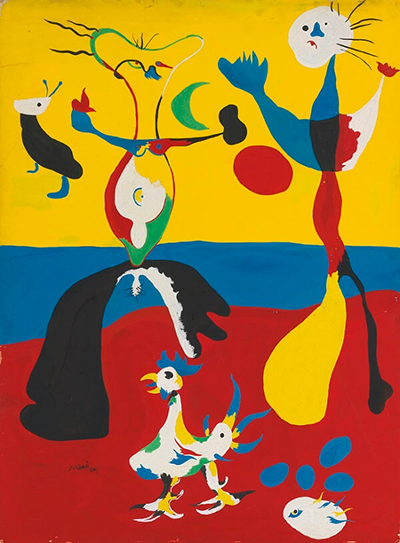This is one of the more accessible artworks from Joan Miro, where the majority of figures are recognisable and the overall theme and meaning is easy to decipher.
The Farmer and his Wife is one of many paintings from this artist which focused on the Spanish countryside, normally directly from the village in which he lived for many years. We see him cover Catalan peasants a number of times and this may have been encouraged by earlier French art from previous centuries, such as the members of the Barbizon School who included Jean-François Millet, Théodore Rousseau and Charles-François Daubigny. Furthermore, Salvador Dali, another Catalan artist who was connected to Miro through their use of Surrealism, would frequently gain inspiration from one specific Millet artwork, namely The Gleaners, as shown in Archeological Reminiscence Millet's Angelus.
This painting achieved a price of $10,401,000 at auction in a relatively recent sale. It therefore ranks as one of the more expensive sales from his career, but it is likely that prices will go far beyond this in future, as fewer and fewer artworks become available. For this reason, many collectors see famous art like this as an excellent investment opportunity, particularly seeing as Miro's reputation looks fully established within the realms of art history and he continues to receive a prominent interest today, as much as ever. There are also a number of museums dedicated to his work that ensures his own name retains its strength for future generations, just as with other notable Catalans such as Gaudi and Dali.
It is believed that Miro's father bought their farmhouse in around 1911 and this would have been the beginning of the artist's love affair with the Catalan countryside. He chose a bright yellow for the sky because of the warmth that it brings as well as how it perfectly complements the blue sea.
"...I came back here again after that exhibit [an exhibition at la Licorne in Paris] And again Montroig reached out to me with all its light, all its life, and I wanted to capture that whole period that I could see from Montroig and I painted The Farm. Nine months of constant hard work! Nine months of painting every day and wiping it out and making studies and destroying them all. The Farm was a resumé of my entire life in the country. I wanted to put everything I loved about the country into that canvas - from a huge tree to a tiny little snail. I don't think it makes sense to give more importance to a mountain than an ant (but landscape artists just can't see that), and that's why I didn't hesitate to spend hours and hours making the ant come alive..."




